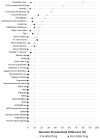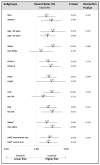Impact of Physical Inactivity on Mortality in Patients With Heart Failure
- PMID: 26853954
- PMCID: PMC4799780
- DOI: 10.1016/j.amjcard.2015.12.060
Impact of Physical Inactivity on Mortality in Patients With Heart Failure
Abstract
The impact of physical inactivity on heart failure (HF) mortality is unclear. We analyzed data from the HF Adherence and Retention Trial (HART) which enrolled 902 patients with New York Heart Association class II/III HF, with preserved or reduced ejection fraction, who were followed for 36 months. On the basis of mean self-reported weekly exercise duration, patients were classified into inactive (0 min/week) and active (≥1 min/week) groups and then propensity score matched according to 34 baseline covariates in 1:2 ratio. Sedentary activity was determined according to self-reported daily television screen time (<2, 2 to 4, >4 h/day). The primary outcome was all-cause death. Secondary outcomes were cardiac death and HF hospitalization. There were 196 inactive patients, of whom 171 were propensity matched to 342 active patients. Physical inactivity was associated with greater risk of all-cause death (hazard ratio [HR] 2.01, confidence interval [CI] 1.47 to 3.00; p <0.001) and cardiac death (HR 2.01, CI 1.28 to 3.17; p = 0.002) but no significant difference in HF hospitalization (p = 0.548). Modest exercise (1 to 89 min/week) was associated with a significant reduction in the rate of death (p = 0.003) and cardiac death (p = 0.050). Independent of exercise duration and baseline covariates, television screen time (>4 vs <2 h/day) was associated with all-cause death (HR 1.65, CI 1.10 to 2.48; p = 0.016; incremental chi-square = 6.05; p = 0.049). In conclusion, in patients with symptomatic chronic HF, physical inactivity is associated with higher all-cause and cardiac mortality. Failure to exercise and television screen time are additive in their effects on mortality. Even modest exercise was associated with survival benefit.
Trial registration: ClinicalTrials.gov NCT00018005.
Copyright © 2016 Elsevier Inc. All rights reserved.
Conflict of interest statement
Figures





References
-
- Proper KI, Singh AS, van Mechelen W, Chinapaw MJ. Sedentary behaviors and health outcomes among adults: a systematic review of prospective studies. Am J Prev Med. 2011;40:174–182. - PubMed
-
- Andersen K, Mariosa D, Adami HO, Held C, Ingelsson E, Lagerros YT, Nyren O, Ye W, Bellocco R, Sundstrom J. Dose-response relationship of total and leisure time physical activity to risk of heart failure: a prospective cohort study. Circ Heart Fail. 2014;7:701–708. - PubMed
-
- Young DR, Reynolds K, Sidell M, Brar S, Ghai NR, Sternfeld B, Jacobsen SJ, Slezak JM, Caan B, Quinn VP. Effects of physical activity and sedentary time on the risk of heart failure. Circ Heart Fail. 2014;7:21–27. - PubMed
Publication types
MeSH terms
Associated data
Grants and funding
LinkOut - more resources
Full Text Sources
Other Literature Sources
Medical
Research Materials
Miscellaneous

